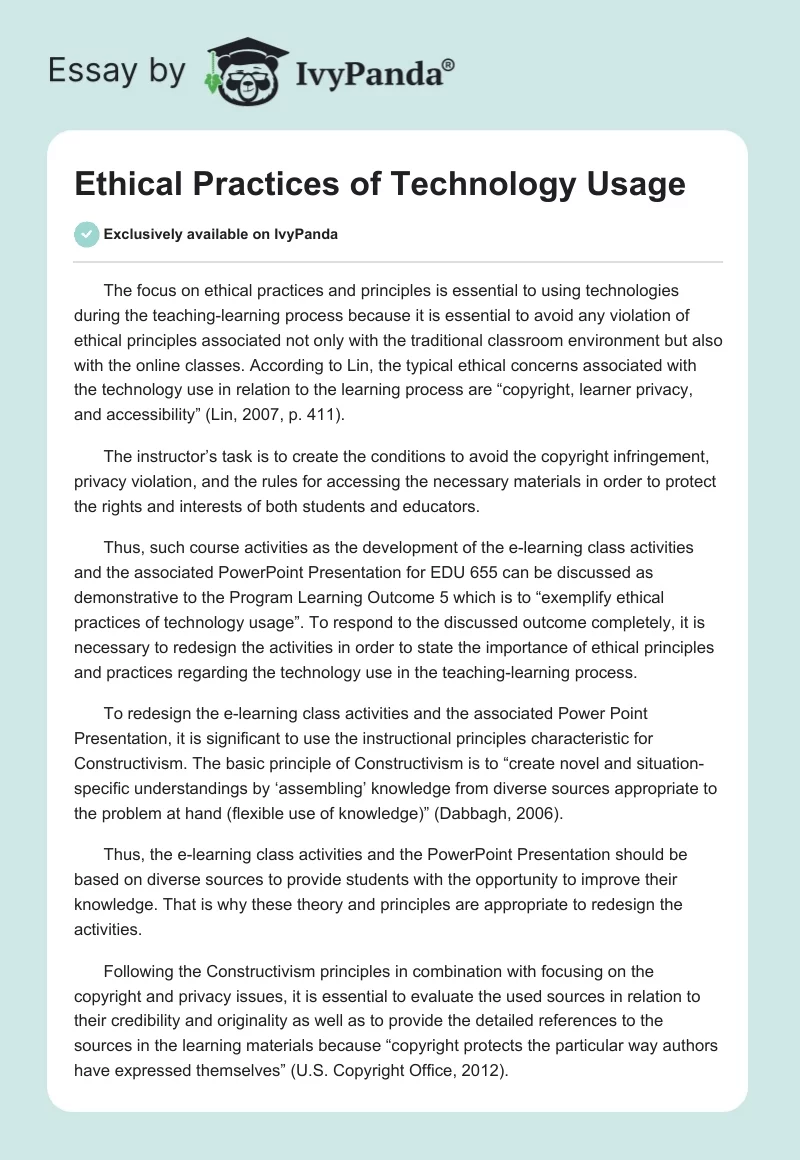The focus on ethical practices and principles is essential to using technologies during the teaching-learning process because it is essential to avoid any violation of ethical principles associated not only with the traditional classroom environment but also with the online classes. According to Lin, the typical ethical concerns associated with the technology use in relation to the learning process are “copyright, learner privacy, and accessibility” (Lin, 2007, p. 411).
The instructor’s task is to create the conditions to avoid the copyright infringement, privacy violation, and the rules for accessing the necessary materials in order to protect the rights and interests of both students and educators.
Thus, such course activities as the development of the e-learning class activities and the associated PowerPoint Presentation for EDU 655 can be discussed as demonstrative to the Program Learning Outcome 5 which is to “exemplify ethical practices of technology usage”. To respond to the discussed outcome completely, it is necessary to redesign the activities in order to state the importance of ethical principles and practices regarding the technology use in the teaching-learning process.
To redesign the e-learning class activities and the associated Power Point Presentation, it is significant to use the instructional principles characteristic for Constructivism. The basic principle of Constructivism is to “create novel and situation-specific understandings by ‘assembling’ knowledge from diverse sources appropriate to the problem at hand (flexible use of knowledge)” (Dabbagh, 2006).
Thus, the e-learning class activities and the PowerPoint Presentation should be based on diverse sources to provide students with the opportunity to improve their knowledge. That is why these theory and principles are appropriate to redesign the activities.
Following the Constructivism principles in combination with focusing on the copyright and privacy issues, it is essential to evaluate the used sources in relation to their credibility and originality as well as to provide the detailed references to the sources in the learning materials because “copyright protects the particular way authors have expressed themselves” (U.S. Copyright Office, 2012).
That is why, to redesign the activities and created materials, it was essential to evaluate the sources used and to revise the citations in order to provide all the necessary information about the sources’ origin and authors.
Any quotes, materials, and images should be cited correctly in order to avoid the copyright infringement and to demonstrate significance of the above-mentioned ethical principles to students. Thus, the accuracy of the data used was evaluated with the help of examining the used sources and websites thoroughly, and the necessary information about the causes such as the full title of the source and full date was added to the materials.
Nevertheless, while redesigning the project, such challenges as the necessity to evaluate the credibility of the used sources and the origin of the material were experienced.
For instance, it was somewhat difficult to check all the provided privacy and copyright information on the site to state its credibility and to refer to several links in order to determine the originality of the cited researches because of a range of copy materials on the Internet which can be used inappropriately. These challenges were overcome with the help of examining all the provided information properly in order to address the ethical principles of technology usage.
Thus, to contribute to the development of the effective teaching-learning process based on using technologies, it is necessary to refer to the associated ethical principles and practices.
References
Dabbagh, N. (2006). Instructional design knowledge base. Web.
Lin, H. (2007). The ethics of instructional technology: Issues and coping strategies experienced by professional technologists in design and training situations in higher education. Educational Technology Research and Development, 55(1), 411-437.
U.S. Copyright Office. (2012). Fair use. Web.


